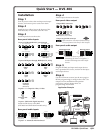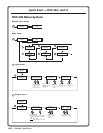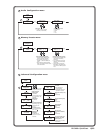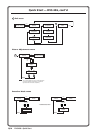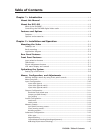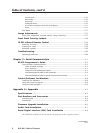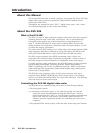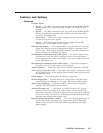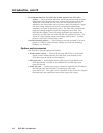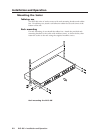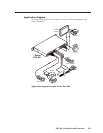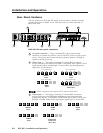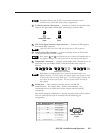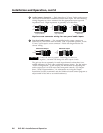
1-3DVS 406 • Introduction
Features and Options
Features
Six video inputs —
• Input 1 — Five BNC connectors on the rear panel accept RGBHV/RGBS/
RGsB computer video for pass-through, or HDTV YUV video for pass-
through.
• Input 2 — Five BNC connectors on the rear panel accept RGBHV/RGBS/
RGsB as pass-through computer video, RGBcS, and component video
(interlaced and progressive).
• Inputs 3 to 5 — Three pairs of BNC connectors on the rear panel accept
S-video or composite video signals.
• Input 6 — DVS 406 D and DVS 406 AD are equipped with an SDI
connector for a serial digital interface signal.
Buffered video outputs — Five rear-panel BNC connectors and one VGA-type
15-pin HD connector provide connections for RGB or component video
(YUV) output. Both outputs (the BNCs and the 15-pin HD connector) are
active at all times for simultaneous output.
Six balanced or unbalanced stereo audio inputs — The audio versions of the
DVS 406 (406 A and 406 AD) are equipped with six rear panel captive
screw connectors that accept audio inputs. Each input’s audio level level
can be individually set.
One balanced or unbalanced stereo audio output — One line level output is
provided on 3.5 mm, 5-pole captive screw terminals.
Audio breakaway — Audio and video can be switched separately via RS-232.
Three ways to control the scaler — The scaler’s front panel, a computer or other
RS-232 control device, or the optional IR 901 remote control can all be used
to control the scaler.
Scaled outputs — The DVS 406 offers 55 different output rates.
RS-232 configuration — The DVS 406 can be configured by using the Extron
control software for Windows, or by using a third party control system.
Triple-Action Switching
™
— With this method, a blank screen is displayed
while the DVS 406 switches between inputs.
Accu-RATE Frame Lock
™
— The Extron Accu-RATE Frame Lock™ (patent
pending) eliminates artifacts from scaled motion video by eliminating
frame rate conversion. It locks the output frame rate to the input frame rate
of the active input. The result is a switching system that eliminates image
tears and other artifacts from motion video.
Dynamic Motion Interpolation
™
(DMI
™
) — This video processing technique is
an advanced motion prediction and compensation method that treats
motion content and still content with different algorithms to yield high
fidelity images.



